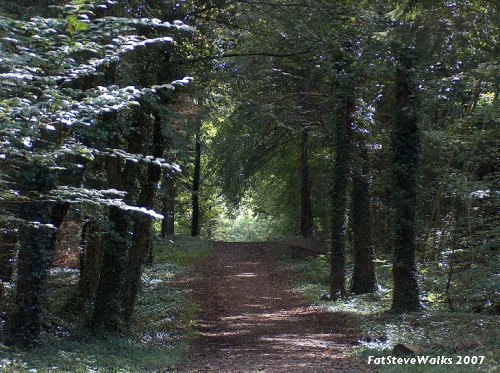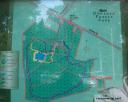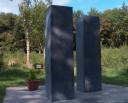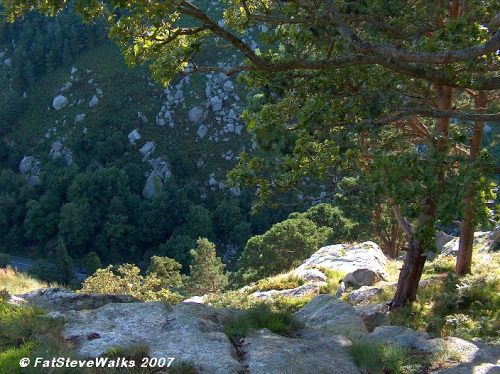A gentle 6km forest walk within easy reach of Dublin, with a ruined castle and a 9/11 memorial.

The return of good weather at last has seen me looking to take slightly longer walks again – I’ve been trying hard to keep up my walking to fitness routine through the rainy days, but not blogging it, as I’m fairly sure that “walked up and down xyz road for the fifth time this week” would not exactly make for exciting reading.
I was lucky enough to have today (Monday 27th August) off work, and decided to head off in the car to somewhere I had not been before. A quick scan of the Coillte website – http://www.coillte.ie – turned up Donadea as a good possibility: not too far from Dublin, big enough to have a a 5+ km walk, and not somewhere I have been before.
Getting to Donadea in Co. Kildare is fairly easy, though the directions on the Coillte website do lack some vital details. You can reach it either by taking the R407 south from the Kilcock junction of the M4, or the R407 north from the centre of Naas.
Coillte would give you the impression that the forest park is actually on this road, but it is 3 or 4 km west of it, reached via a righthand turn (if coming from the M4) or lefthand (from Naas) – just look out for the brown tourist sign marking the turnoff, and follow that. The park will eventually be on your left.
Entry fee is €4 per car, payable in exact money only, to a mechanised barrier, which only accepts €1 or €2 coins. Once inside the park there is ample car parking and also a shop and toilets (which we will come to later).
At the bottom of the car park there is a good map of the park, on which our walk is clearly marked in blue.

(click on any small image to see fullsize version – this one is particularly useful, as it’s a photo of the map!)
There are various walks possible in the park, my choice being the blue, or “Aylmer” walk, which is the longest, circling most of the forest. This can be walked in either direction, but I chose, and would reccomend, clockwise, as it saves the lake, the tea shop and the ruined castle for the end rather than having them near the beginning.
To do the walk in a clockwise direction, head back from the carpark towards the entry road, and the walk is just beyond the end of the car park, on your right if the car park is behind you, and very clearly signed.

From here the walk proceeds to the east, along a gravel surfaced pathway. After about 500m you will reach a T and turn to the right – this and all major junctions are clearly signposted for all the different walks. Just keep following the blue signs.

Walking now along the eastern side of the forest, the route passes through a large area of mostly pine trees, and being the longer walk, is less popular, and for the most part deserted.

The planting, as usual with pine forests, is very dense, with occasional larger and smaller firebreaks, pathways and ditches leading off on either side.
One narrow firebreak leading between trees was almost tunnel-like, and very dark, and I couldn’t resist venturing some way down it in order to try getting shots at different exposure levels to see how the patterns of light and shade looked in picture.

Re-emerging suddenly from this hidden pathway onto the main track I did rather startle two young walkers who must have thought themselves alone on this seemingly empty track, and they looked anxiously at each other as I appeared in front of them, busy tucking my shirt in from where it had come out as I crouched down to get the best camera angles. They looked quite relieved when I purposefully waddled off in the other direction!
The walk around the eastern and southern sides of the forest is peaceful and lovely, and here and there are dotted benches for the weary. The circular nature of the trail also means that to cut the walk short, you simply have to take one of the intersecting paths to the right, though I’d reccomend the full 5.7km if you are up for it.
Gradually the end of the southern boundary is reached, and the pathway turns north, now leading through mostly mixed native woodland.

This part is mostly uphill, though fairly gentle. A little while after passing a turning labelled “nature walk” to the right, theblue trail itself turns to the right, and heads through a plantation of ash towards the forest’s 9/11 memorial site.
The memorial, standing in the middle of peaceful forest, is both well designed and also very peaceful.
Two stone pillars are placed in the size and positioning of the Twin Towers, and are inscribed with the names and ranks of the firefighters, police, and port officials who died in the rescue attempt, while nearby benches are dedicated to the passengers on the hijacked planes.


From here the pathway curves back to head towards the centre of the forest, where the lake and tearooms are, though before reaching them it passes one side of the ruins of an old castle.

Very shortly beyond the castle, the lake is reached, and this marks the end of the walk, the car-park being reached by a main avenue leading past the tea rooms and the from of the ruined castle.


The entire walk took me about an hour and a half, though this was with frequent stops for photographs, and a few side trips (and the odd scaring of other walkers!). A fitter walker could easily do it in an hour.
I’ll be putting this up on the “Walks by Car” section in due course.
More soon, if the weather holds, if not, its back towalking up and down xyz road in the rain.
Fat Steve

































